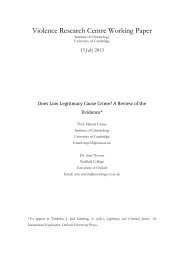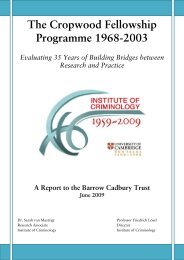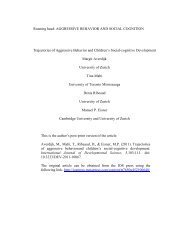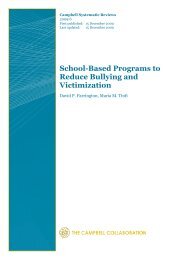What Causes Large-scale Variation in Homicide Rates? - Institute of ...
What Causes Large-scale Variation in Homicide Rates? - Institute of ...
What Causes Large-scale Variation in Homicide Rates? - Institute of ...
You also want an ePaper? Increase the reach of your titles
YUMPU automatically turns print PDFs into web optimized ePapers that Google loves.
Page 1<strong>What</strong> <strong>Causes</strong> <strong>Large</strong>-<strong>scale</strong> <strong>Variation</strong> <strong>in</strong> <strong>Homicide</strong> <strong>Rates</strong>?Manuel Eisner<strong>Institute</strong> <strong>of</strong> Crim<strong>in</strong>ologyUniversity <strong>of</strong> Cambridge(Work<strong>in</strong>g Paper, July 2012)F<strong>in</strong>al revised version to be published <strong>in</strong><strong>in</strong> He<strong>in</strong>ze, Juergen and Kortuem, Henn<strong>in</strong>g (eds.) Aggression <strong>in</strong> Humans and Primates. Berl<strong>in</strong>: deGruyter.
Page 2Violence – i.e. the <strong>in</strong>tentional <strong>in</strong>fliction or threat <strong>of</strong> physical harm aga<strong>in</strong>st another person – is apervasive feature <strong>of</strong> human societies. There is no known human society where the equivalents <strong>of</strong> assault,rape, robbery, or murder do not occur. The omnipresence <strong>of</strong> violence amongst members <strong>of</strong> the humanspecies has led some researchers to argue that violence has evolutionary roots <strong>in</strong> the development <strong>of</strong>humank<strong>in</strong>d dur<strong>in</strong>g the Pleistocene (2 Mio years ago). Accord<strong>in</strong>g to this view violence was not always thedysfunctional ‘disease’ or abhorred crime as which it appears to be <strong>in</strong> contemporary societies. Rather,evolutionary psychologists argue, violence had a number <strong>of</strong> uses that <strong>in</strong>creased the likelihood <strong>of</strong> survival<strong>of</strong> a person who is sometimes aggressive over somebody who is always peaceful (Buss & Shackelford,1997; Eisner, 2009).But while violence seems to be a human universal, there also exists a lot <strong>of</strong> variation <strong>in</strong> the amount<strong>of</strong> violence <strong>in</strong> any society at a given moment <strong>of</strong> time. In some societies violent attacks by others accountfor up to 60% <strong>of</strong> all deaths, mak<strong>in</strong>g violence a hugely important factor <strong>in</strong> one’s chances to survive(Knauft et al., 1991; Robarchek & Robarchek, 1998). In other societies lethal <strong>in</strong>terpersonal violenceaccounts for less than 0.05% <strong>of</strong> all deaths, mean<strong>in</strong>g that it barely affects the overall life expectancy <strong>of</strong> apopulation. This suggests that the extent to which humans primarily display co-operative and car<strong>in</strong>g orantagonistic and violent behaviour depends on social circumstances (Roth, 2011).This paper exam<strong>in</strong>es homicide, the best documented manifestation <strong>of</strong> violence. In particular, itexam<strong>in</strong>es whether any generalizable conclusions can be drawn from three research traditions that havetried to understand why societies differ <strong>in</strong> levels <strong>of</strong> homicide. The three research traditions exam<strong>in</strong>ed hereare a) crim<strong>in</strong>ological research on cross-national differences <strong>in</strong> homicide, b) comparative anthropologicalresearch on levels <strong>of</strong> lethal violence <strong>in</strong> non-state societies, and c) historical research on the factors thataffect long-term variation <strong>in</strong> homicide rates over time. Many researchers believe that homicide is probablya good lead <strong>in</strong>dicator <strong>of</strong> overall levels <strong>of</strong> <strong>in</strong>terpersonal violence <strong>in</strong> a society. However, the extent to whichthis assumption is true is not clear, and one should bear <strong>in</strong> m<strong>in</strong>d that different manifestations <strong>of</strong> violencemay have different distributions across societies and over time. Thus, the large-<strong>scale</strong> variation <strong>in</strong> thefrequency <strong>of</strong> rape, robbery, wife beat<strong>in</strong>g or <strong>in</strong>fanticide may be partly correlated with the distribution <strong>of</strong>homicide, but each <strong>of</strong> these behaviours is probably also <strong>in</strong>fluenced by specific factors.The first section will exam<strong>in</strong>e the extent <strong>of</strong> variation <strong>in</strong> homicide across human societies. I thenexam<strong>in</strong>e the extent to which some characteristics <strong>of</strong> ‘homicide’ differ between relatively peaceful societiesand violent societies. This is important because we need to understand whether peaceful and violentsocieties simply have more or less <strong>of</strong> the same problems, or whether homicide <strong>in</strong> high-violence societiesdiffers systematically from homicide <strong>in</strong> low homicide societies. In a third section I discuss empiricalresearch <strong>in</strong> each research tradition on the factors that are systematically associated with variation <strong>in</strong>homicide levels, both over time and between societies. In a f<strong>in</strong>al section I exam<strong>in</strong>e some research gapsand strategies for future research.
Page 4state societies have many limitations, and comparisons with data from bureaucratic nation-states must bemade with great caution. First, the estimates from many studies derive from societies that have hadcontact with Western societies or that had effectively been colonialized (e.g. Bohannan, 1960). Evidencefrom such societies may have been <strong>in</strong>fluenced – <strong>in</strong> either direction - by the consequences <strong>of</strong> Westerncultural, political and economic dom<strong>in</strong>ation. Second, many estimates for simple societies relate to smallsocieties <strong>of</strong> sometimes just a few hundred members and are based on recollections <strong>of</strong> violent deaths asrecorded <strong>in</strong> ethnographic <strong>in</strong>terviews. Such estimates can be subject to wild fluctuations as a result <strong>of</strong>small numbers, and it is difficult to determ<strong>in</strong>e to what extent they are subject to bias. Third, some studiessuch as the well-known analysis by Keeley (1996) <strong>in</strong>discrim<strong>in</strong>ately comb<strong>in</strong>e deaths from <strong>in</strong>tra-group and<strong>in</strong>ter-group (war) conflict. While this is a defensible strategy if one is <strong>in</strong>terested <strong>in</strong> overall levels <strong>of</strong> lethalityfrom human conflict, it results <strong>in</strong> a lack <strong>of</strong> comparability to modern statistics, where deaths result<strong>in</strong>g fromwar and deaths due to homicide are clearly separated. Fourth, one needs to bear <strong>in</strong> m<strong>in</strong>d that <strong>in</strong> anysociety without a function<strong>in</strong>g state it is impossible to clearly dist<strong>in</strong>guish capital punishment as a strategy torestore order from homicide as a transgression <strong>of</strong> moral rules (Boehm, 1984; Chagnon, 1988). Thus,many violent deaths <strong>in</strong> non-state societies were considered justifiable s<strong>in</strong>ce they were permissiblereactions to a previous harm such as theft or adultery, and hence equivalent to punishment <strong>in</strong> a stateorganizedsociety. F<strong>in</strong>ally, it is important to recognize that all ‘simple’ societies had very limited abilities totreat wounds result<strong>in</strong>g from <strong>in</strong>jury, mean<strong>in</strong>g that a far greater proportion <strong>of</strong> traumas resulted <strong>in</strong> deaththan is the case <strong>in</strong> modern societies.All together, these three datasets represent several hundreds <strong>of</strong> estimates <strong>of</strong> homicide rates from allparts <strong>of</strong> the world, different historical periods, and both state-organized and non-state societies. Despitetheir limitations, they give an impression <strong>of</strong> the variation <strong>in</strong> homicide rates across human societies. Toillustrate this amount <strong>of</strong> variation I have placed a small selection <strong>of</strong> estimates from each <strong>of</strong> the three datasources on a s<strong>in</strong>gle sp<strong>in</strong>e (figure 1). The sp<strong>in</strong>e, shown on the vertical axis, is displayed on a logarithmic<strong>scale</strong> that ranges from 0.1 per 100,000 person-years to 10,000 per 100,000 person-years, mean<strong>in</strong>g that itcomprises six orders <strong>of</strong> magnitude.
Page 5Figure 1<strong>Homicide</strong> <strong>Rates</strong> <strong>in</strong> Selected Contemporary, Historical, and Non-state Societies10000Rwanda Genocide (1994)1000Monte Rey County (1850s)Gebusi (New Gu<strong>in</strong>ea)Los Angeles (1860s)100Florence (14th c.)Rome (16th c.)Western ApacheHondurasEl SalvadorStockholm (16th c.)!Kung (Namibia)10Cologne (15th c.)NigeriaGisu (Uganda)Unites StatesGeneva (18th c)Kreyol (Dom<strong>in</strong>ica)India1Dijoula (Burk<strong>in</strong>a Faso)Sussex (18th c.)Norway (1880-1900)Tiv (Uganda)Semai (Malaysia)SwitzerlandJapan0.10 1 2 3HistoricalAnthropologicalContemporaryResearchStudiesNation-States
Page 6The World Records <strong>in</strong> PeacefulnessF<strong>in</strong>d<strong>in</strong>g the haven <strong>of</strong> peace where people live harmoniously together has always fasc<strong>in</strong>atedphilosophers and social scientists. <strong>What</strong> exactly ‘peacefulness’ means and whether a low likelihood <strong>of</strong>lethal with<strong>in</strong>-society conflict is an acceptable operationalization, may be open to contention. There was atime when researchers <strong>in</strong>terested <strong>in</strong> peaceful societies were primarily look<strong>in</strong>g for simple pre-state societies(Bonta, 1996; Mead, 1928). However, the illustrative data shown <strong>in</strong> figure 1 and more comprehensiveanalyses suggest that some modern, highly developed societies may be as close to the ideal <strong>of</strong> a peacefulsociety as any other.The tables <strong>of</strong> <strong>of</strong>ficially recorded homicide rates <strong>in</strong> modern states such as those compiled for theGlobal Study on <strong>Homicide</strong> (United Nations Office on Drugs and Crime, 2011) suggest that the lowestnational homicide rates found <strong>in</strong> today’s world are around 0.5 cases per 100,000 <strong>in</strong>habitants per year. Atsuch rates homicide becomes a very marg<strong>in</strong>al cause <strong>of</strong> death, account<strong>in</strong>g for around 0.04% <strong>of</strong> all deaths <strong>in</strong>any given year. Accord<strong>in</strong>g to the UNODC database there existed several contemporary societies withhomicide rates <strong>of</strong> about 0.5 <strong>in</strong> around 2005-08. This <strong>in</strong>cludes Hong Kong (0.5), S<strong>in</strong>gapore (0.5) and Japan(0.5) <strong>in</strong> Eastern Asia; Bahra<strong>in</strong> (0.6), Oman (0.7) and the United Arab Emirates (0.8) <strong>in</strong> the Middle East;and Norway (0.6), Slovenia (0.6), Austria (0.5) and Switzerland (0.7) <strong>in</strong> Europe. In Africa or the Americasno nation-state is currently recorded with a homicide rate <strong>of</strong> less than 1 per 100,000.Remarkably, historical data on homicide rates suggest a similar lower boundary dur<strong>in</strong>g the history<strong>of</strong> Europe or the United States over the past centuries. For example, the European <strong>Homicide</strong> Databasesuggests a cluster <strong>of</strong> countries <strong>in</strong>clud<strong>in</strong>g Sweden, Denmark, Norway and the Netherlands <strong>in</strong> the late 19 thand early 20 th century that had remarkably few homicides. In Norway, for example, the mortality statisticsbetween 1875 and 1900 report an average <strong>of</strong> 9 non-<strong>in</strong>fant deaths due to murder or manslaughter eachyear. In a country with a population <strong>of</strong> 2 Million people this equals a homicide rate <strong>of</strong> about 0.45 per100,000. This is particularly impressive as emergency services <strong>in</strong> the late 19 th century were considerablyless effective than they are today and Norway was a relatively poor, sparsely populated and rural country,where trauma victims were unlikely to receive specialist treatment. No exact estimates exist on the impact<strong>of</strong> emergency services on the mortality risk <strong>of</strong>, for example, stab wounds. However, Monkkonen (2001)estimates that probably half <strong>of</strong> all violent deaths that occurred <strong>in</strong> the mid-19 th century could have beenprevented with modern technology. This implies that the late 19 th century homicide rates <strong>of</strong> Norwaymight be equivalent to a rate <strong>of</strong> around 0.2 per 100,000 <strong>in</strong> the contemporary world, once progress <strong>in</strong>medical emergency technology is taken <strong>in</strong>to account. I am not aware <strong>of</strong> any society at any time withfewer with<strong>in</strong>-group lethal conflicts. However, a very similar range <strong>of</strong> values found <strong>in</strong> Denmark and theNetherlands dur<strong>in</strong>g this period, and I believe these rates may be very close to the world records <strong>of</strong>peacefulness as measured by the rate <strong>in</strong>terpersonal kill<strong>in</strong>g with<strong>in</strong> a society.
Page 7However, low homicide rates are not the exclusive prerogative <strong>of</strong> people liv<strong>in</strong>g <strong>in</strong> well-<strong>in</strong>tegratednation states. The evidence reviewed by Nivette (2011b) suggests a lot <strong>of</strong> variation amongst ‘simple’ nonstatesocieties. Some <strong>of</strong> these societies have homicide rates that are very close to those <strong>of</strong> the mostpacified societies found <strong>in</strong> the historical and contemporary data <strong>of</strong> Western Europe. For example, theDioula <strong>in</strong> Burk<strong>in</strong>a Faso – a group known for their important historical and contemporary role as tradersand merchants across the Sahara and the Sahel areas – are reported <strong>in</strong> the study by Faurie and Raymond(2005) to have an estimated homicide rate <strong>of</strong> 1.3 per 100,000. Similarly, several societies studied <strong>in</strong> thecontributions to the volume African <strong>Homicide</strong> and Suicide, published <strong>in</strong> 1960, were found to have very lowlevels <strong>of</strong> homicide. For example, Beattie exam<strong>in</strong>ed homicide amongst the Nyoro, an ethnic group <strong>of</strong>about 110,000 people <strong>in</strong> Uganda. Over the 20-year period from 1935-1955 a total <strong>of</strong> 34 cases <strong>of</strong>completed or attempted <strong>in</strong>tentional homicides were recorded by the district court, the coroner, or the <strong>in</strong>the Police files. This equals a homicide rate <strong>of</strong> about 1.5 attempted and completed homicides per 100,000<strong>in</strong> a society with hardly any medical services – certa<strong>in</strong>ly a remarkably low level, even if the <strong>of</strong>ficial figuresmay be <strong>in</strong>complete. F<strong>in</strong>ally, there is the famous example <strong>of</strong> the Semai, a farm<strong>in</strong>g people liv<strong>in</strong>g <strong>in</strong> smallautonomous bands <strong>in</strong> the ra<strong>in</strong>forest <strong>of</strong> Malaysia, amongst whom physical violence <strong>in</strong>clud<strong>in</strong>g fights amongadults, domestic violence aga<strong>in</strong>st wives or the beat<strong>in</strong>g <strong>of</strong> children appears to be extremely rare. Accord<strong>in</strong>gto Dentan (1968) there were two homicides amongst the Semai (one <strong>of</strong> which was an abandonment <strong>of</strong> anold person) <strong>in</strong> the period between 1955 and 1977 (Robarchek & Robarchek, 1998). With a population <strong>of</strong>about 15,000 this equals a homicide <strong>of</strong> about 0.6 per 100,000, a value that is very similar to what has beenfound to be the range <strong>of</strong> what human societies can achieve <strong>in</strong> contemporary and <strong>in</strong> historical research.The World Records <strong>in</strong> ViolenceIt is unclear whether someth<strong>in</strong>g like an upper limit <strong>of</strong> <strong>in</strong>traspecific kill<strong>in</strong>g exists <strong>in</strong> human societies.There are examples <strong>of</strong> massacres and genocides where humans got as close as possible to wip<strong>in</strong>g outwhole societies. To illustrate the issue I have <strong>in</strong>cluded Rwanda dur<strong>in</strong>g the year <strong>of</strong> the genocide aga<strong>in</strong>st theTutsi m<strong>in</strong>ority <strong>in</strong> 1994 at the top <strong>of</strong> the <strong>scale</strong> <strong>of</strong> homicide rates <strong>in</strong> modern societies. Various estimates putthe death toll at 5-800,000 people with<strong>in</strong> a few months, equal to about 10% <strong>of</strong> the population or ahomicide rate <strong>of</strong> 10,000 per 100,000. Of course, the rate would be even higher if we calculated a separaterate for the Tutsi m<strong>in</strong>ority, but exact figures are not relevant here. The issue is whether such ‘extreme’and organized k<strong>in</strong>ds <strong>of</strong> large-<strong>scale</strong> kill<strong>in</strong>gs should be placed on a s<strong>in</strong>gle sp<strong>in</strong>e <strong>of</strong> violence as suggested <strong>in</strong>Figure 1. Most crim<strong>in</strong>ologists don’t consider themselves competent to analyse these k<strong>in</strong>ds <strong>of</strong> levels <strong>of</strong>kill<strong>in</strong>gs, believ<strong>in</strong>g that genocides and civil wars are someth<strong>in</strong>g entirely different from crim<strong>in</strong>al homicide,and better analysed by sociologists or political scientists. I don’t believe this is true. Rather, the s<strong>in</strong>glesp<strong>in</strong>e used <strong>in</strong> figure 1 reflects my assumption that there is a cont<strong>in</strong>uum from the more <strong>in</strong>dividual‘traditional’ types <strong>of</strong> pathological murder to the organized elim<strong>in</strong>ation <strong>of</strong> whole population groups.
Page 8If we ignore such extreme cases as Rwanda <strong>in</strong> 1994 and focus on homicide <strong>in</strong> the more narrowsense, we f<strong>in</strong>d that the highest rates <strong>of</strong> recorded homicide <strong>in</strong> the modern world are between 50 and 100per 100,000 <strong>in</strong>habitants. In the UNODC statistics the countries with the highest homicide rates wereHonduras (82.1), El Salvador (66.0), Cote d’Ivoire (56.9), and Jamaica (52.0). In all four countries endemicviolence, much <strong>of</strong> it associated with organized groups, is a major problem and homicide constitutes amajor cause <strong>of</strong> death, especially amongst young men, who are the most highly affected group <strong>of</strong> victims.Also, the national averages mask a lot <strong>of</strong> regional variation, mean<strong>in</strong>g that violence levels <strong>in</strong> some regionswill be much higher than the respective national averages.While these four countries certa<strong>in</strong>ly suffer from very serious levels <strong>of</strong> violence, it is possible thatUNODC statistics seriously underestimate the values <strong>of</strong> some other countries. For example, the GlobalStudy on <strong>Homicide</strong> counts 608 homicides <strong>in</strong> Iraq <strong>in</strong> 2008, equivalent to a homicide rate <strong>of</strong> 2.0 per 100,000.This would make Iraq <strong>in</strong> 2008 one <strong>of</strong> the most peaceful places <strong>in</strong> the world. It is unclear, how this figurewas arrived at, but it must exclude a very large number <strong>of</strong> civilian deaths related to the political <strong>in</strong>stabilityand sectarian violence <strong>in</strong> the country. Accord<strong>in</strong>g to the Iraq Body Count project, for example, there werealmost 10,000 civilian violent deaths <strong>in</strong> Iraq <strong>in</strong> 2008, which would amount to a homicide rate for 2008 <strong>of</strong>about 30 per 100,000. Even more stunn<strong>in</strong>gly, the UNODC report presents a figure <strong>of</strong> 138 homicides forSomalia <strong>in</strong> 2008, equivalent to a rate <strong>of</strong> 1.5 per 100,000 <strong>in</strong> 2008 and correspond<strong>in</strong>g to a level that wouldput the homicide rate <strong>in</strong> Somalia close to that <strong>of</strong> politically stable and affluent societies <strong>in</strong> WesternEurope. In that year Somalia was <strong>in</strong> the midst <strong>of</strong> a cruel civil war with gangs <strong>of</strong> rival war-lords fight<strong>in</strong>geach other <strong>in</strong> Mogadishu and other cities. Accord<strong>in</strong>g to the Mogadishu-based Elman Peace and HumanRights Organisation the number <strong>of</strong> civilian deaths <strong>in</strong> 2008 was around 7,500 persons, more than fifty timesthe figure <strong>in</strong> the homicide statistics. These <strong>in</strong>consistencies illustrate two problems that we <strong>of</strong>ten observe<strong>in</strong> societies with high levels <strong>of</strong> violence: One is that under such conditions the bureaucratic structures thatare responsible for collect<strong>in</strong>g <strong>in</strong>formation about causes <strong>of</strong> death stop operat<strong>in</strong>g, mean<strong>in</strong>g that data will be<strong>in</strong>complete. The other problem is that under such conditions the dist<strong>in</strong>ction between ‘crim<strong>in</strong>al’<strong>in</strong>terpersonal violence, political violence and civil war becomes <strong>in</strong>creas<strong>in</strong>gly blurred.Historical research has uncovered a number <strong>of</strong> societies with very high rates <strong>of</strong> homicides. InEurope, for example, some studies f<strong>in</strong>d very high rates <strong>of</strong> homicide <strong>in</strong> some cities <strong>in</strong> the Middle Ages andthe Early modern period – although the notion <strong>of</strong> general lawless and pervasive violence <strong>in</strong> the highMiddle Ages is certa<strong>in</strong>ly wrong (Dean, 2001). For example, local studies for 14 th century Florence (Becker,1976), 16 th century Stockholm (Karonen, 2001) or medieval Utrecht (Berents, 1976) suggest that the upperlimit are homicide rates <strong>in</strong> the range <strong>of</strong> 50-150 per 100,000 <strong>in</strong>habitants over extended periods <strong>of</strong> time,although Spierenburg (2001) quotes a homicide rate as high as about 700 per 100,000 for Corsica <strong>in</strong> theearly 18 th century.In the United States, Roth documents some very high homicide rates dur<strong>in</strong>g the early phases <strong>of</strong>European colonialisation. For early 17 th century Virg<strong>in</strong>ia Roth reports a homicide rate <strong>of</strong> about 250 per
Page 9100,000 (Roth, 2009: 37), and a rate <strong>of</strong> almost 500 per 100,000 for Maryland dur<strong>in</strong>g the same period.Roth expla<strong>in</strong>s that this rate was not solely the result <strong>of</strong> the clash between settlers and Native Americans:“Non Puritans killed Puritans; the Dutch killed their fellow Dutch; Englishmen killed Frenchmen; andFrenchmen retaliated. Men died <strong>in</strong> clashes between rival governments and political factions that fought tocontrol trade and territory” (Roth, 2009: 27).Some ethnographic studies have come up with even higher estimates. Amongst these, the estimatesprovided by Lawrence Keeley <strong>in</strong> War before Civilization (Keeley, 1996) are particularly remarkable, not leastbecause they have been cited prom<strong>in</strong>ently <strong>in</strong> the more recent work by P<strong>in</strong>ker (2011). Amongst others,Keeley reports rates <strong>of</strong> violent deaths <strong>of</strong> about 1450 per 100,000 for the Kato tribe <strong>in</strong> California dur<strong>in</strong>gthe 1840 or <strong>of</strong> 970 per 100,000 <strong>in</strong> the 1920s for the D<strong>in</strong>ka, an agripastoral group without central politicalauthority <strong>in</strong> what is now Sudan, who had a long tradition <strong>of</strong> cattle-raid<strong>in</strong>g and encroachment on graz<strong>in</strong>glands <strong>of</strong> their neighbours (Fluehr-Lobban, 1976). Similar rates have been documented for a range <strong>of</strong>hunter-gatherer and horticultural societies across the globe. They imply that <strong>in</strong> some agropastoralsocieties up to 1% <strong>of</strong> the population were killed by violent acts each year, which <strong>in</strong> turn means that up to50% <strong>of</strong> men could expect to die through violence (Schiefenhoevel, 1988).However, it should be borne <strong>in</strong> m<strong>in</strong>d that these and similar data are reported by Keeley and Knauft(Knauft, 1987) relate to lethal violence <strong>in</strong> a much broader sense as they <strong>in</strong>clude, besides the conflicts wewould identify as homicides, wars with neighbours, conflicts with<strong>in</strong> tribes, and capital punishments forperceived transgressions such as theft, adultery or witchcraft.2. <strong>Variation</strong> <strong>of</strong> <strong>What</strong>?<strong>Homicide</strong> is a judicial category, which lumps together all cases where the <strong>in</strong>tentional <strong>in</strong>fliction <strong>of</strong> atrauma by a person leads to the death <strong>of</strong> another person – and the perpetrator is not legitimized by thestate to <strong>in</strong>flict the lethal trauma (e.g. <strong>in</strong> a war or as an executioner). As a behavioural category homicidetherefore is a mix <strong>of</strong> very different situations. This raises the question <strong>of</strong> whether the characteristics <strong>of</strong>homicides (and <strong>of</strong> violence more generally) are broadly similar <strong>in</strong> societies with much and with little<strong>in</strong>terpersonal violence, the only difference be<strong>in</strong>g that there is more or less <strong>of</strong> the same phenomenon, orwhether different k<strong>in</strong>ds <strong>of</strong> violence dom<strong>in</strong>ate <strong>in</strong> high violence societies as compared to pacified societies.This is an important issue to address if one wants to understand the causes <strong>of</strong> macro-level variation <strong>in</strong>violence. The reason is that some types <strong>of</strong> violence or some groups <strong>of</strong> perpetrators may be more strongly<strong>in</strong>fluenced by contextual conditions related to the likelihood <strong>of</strong> violence than others.Currently there is limited consolidated knowledge about which contextual aspects <strong>of</strong> homicide are<strong>in</strong>variant across societal levels <strong>of</strong> homicide and which aspects vary <strong>in</strong> systematic way. However, it seemsthat for some aspects <strong>of</strong> homicide different comparative studies converge to similar f<strong>in</strong>d<strong>in</strong>gs. I brieflyreview a selection <strong>of</strong> relevant aspects. It is mostly based on
Page 10Sex <strong>of</strong> perpetrators: It is clear from empirical studies across the world that the vast majority <strong>of</strong>homicides are committed by men (Eisner, 2003; Nivette, 2011b: 11). However, much less is known aboutthe extent <strong>of</strong> variation <strong>in</strong> the proportion <strong>of</strong> male perpetrators. Eisner (2003) has exam<strong>in</strong>ed samples <strong>of</strong>assault and homicide over the past 800 years and concluded that the male perpetrator rate fluctuatedwith<strong>in</strong> a rather narrow range <strong>of</strong> between 3 and 15%, with no clear trend over time or between societies.Some isolated f<strong>in</strong>d<strong>in</strong>gs may suggest that the preponderance <strong>of</strong> male perpetrators is even greater <strong>in</strong> highhomicide societies than <strong>in</strong> pacified societies. However, no systematic research has yet been done on thisissue.Social Disadvantage <strong>of</strong> Perpetrators: Evidence from many studies suggests that <strong>in</strong> pacified societies themajority <strong>of</strong> homicides is committed by people who are socially highly marg<strong>in</strong>alized. Perpetrators <strong>of</strong>tenhave no or irregular employment and a large proportion suffers from a comb<strong>in</strong>ation <strong>of</strong> problems<strong>in</strong>clud<strong>in</strong>g substance abuse, mental health problems, etc. In contrast, it seems that <strong>in</strong> highly violentsocieties the perpetration <strong>of</strong> murders and manslaughters is much less constra<strong>in</strong>ed to disadvantagedgroups. Cooney (1997, 1998) has argued that high <strong>in</strong>volvement <strong>of</strong> the elites <strong>in</strong> violence was the rule overlong historical periods, and that it was not limited to political conflicts but <strong>in</strong>cluded a range <strong>of</strong> violentclashes over private matters amongst members <strong>of</strong> the elites, and ruthless lash<strong>in</strong>g out aga<strong>in</strong>st people atlower ranks. Eisner (2003) has presented some empirical evidence support<strong>in</strong>g the idea that historicalsocieties with high levels <strong>of</strong> homicide <strong>of</strong>ten also displayed a high <strong>in</strong>volvement <strong>of</strong> members <strong>of</strong> the elites <strong>in</strong>violent acts. In a similar ve<strong>in</strong>, ethnographic research suggests that <strong>in</strong> some societies with a very highhomicide rate men with a high prowess to fight and kill enjoy a higher social status and have areproductive advantage over other men (Chagnon, 1988; C. R. Ember & Ember, 2007).Sex <strong>of</strong> victims: In most societies the majority <strong>of</strong> homicide victims are men. However, the proportion<strong>of</strong> male homicide victims varies considerably between societies. Accord<strong>in</strong>g to the Global Study on<strong>Homicide</strong> (United Nations Office on Drugs and Crime, 2011), for example, the proportion <strong>of</strong> femalevictims varied between about 50 % <strong>in</strong> Slovenia (53.8%), Korea (51%), Japan (50.0%), Germany (49.6%),Switzerland (49.1%), and Croatia (49.0) and on the one hand, and less than 8% <strong>of</strong> all victims <strong>in</strong>, amongstothers Honduras (6.9%), Paraguay (6.4%), Uganda (6.0%), Venezuela (5.0%), and Sri Lanka (3.7%).Historically, too, a similar range <strong>of</strong> values has been found across European societies between the MiddleAges and the 19 th century (e.g. Eisner, 2003; Hanawalt, 1979; Sharpe, 1981). The sex composition <strong>of</strong>homicide victims seems to differ systematically between high and low homicide societies. Us<strong>in</strong>g historicaldata the F<strong>in</strong>nish crim<strong>in</strong>ologist Veli Verkko (1967) found that <strong>in</strong> societies with low levels <strong>of</strong> homicide theproportion <strong>of</strong> female victims is usually large. In violent societies, <strong>in</strong> contrast, the majority <strong>of</strong> victims(<strong>of</strong>ten 80% and more) are usually men. This relationship seems to hold <strong>in</strong> many different societies overtime and as levels <strong>of</strong> homicide change, and it appears to hold cross-sectionally (Roth, 2009). It impliesthat <strong>in</strong> high violence societies most violence takes place between unrelated males.
Page 11Relationship between perpetrators and victims: A common way to classify homicides is to dist<strong>in</strong>guishbetween different groups <strong>of</strong> relationship between the victim and the perpetrator. The most basicdist<strong>in</strong>ction probably refers to whether the perpetrator and the victim were members <strong>of</strong> the samehousehold or family on the one hand, or whether they were friends, acqua<strong>in</strong>tances or strangers on theother (Wolfgang, 1958). The number <strong>of</strong> domestic homicides as a proportion <strong>of</strong> all homicides committed<strong>in</strong> a society is highly variable. Amongst homicides recorded <strong>in</strong> judicial archives <strong>of</strong> the Middle Ages, forexample, fewer than 10% <strong>of</strong> the cases related to the kill<strong>in</strong>g <strong>of</strong> a family member (Eisner, 2003). In late 19 thcentury England, <strong>in</strong> contrast, when overall homicide rates were much lower, more than half <strong>of</strong> allmurders or manslaughters took place between family members. In England and Wales, members <strong>of</strong> theperpetrator’s family still accounted for about 50% <strong>of</strong> all cases <strong>in</strong> the 1970s, but the proportion dropped toabout 25% by around 2002/3, when overall homicide rates <strong>in</strong> England and Wales were at their highestpo<strong>in</strong>t dur<strong>in</strong>g the 20 th century (Smith, Coleman, Eder, & Hall, 2011). Several historians <strong>of</strong> homicide believethat the proportion <strong>of</strong> domestic homicides varies <strong>in</strong>versely with overall levels <strong>of</strong> homicide <strong>in</strong> the sensethat high homicide societies generally have a low proportion <strong>of</strong> domestic homicides (Eisner, 2003; Roth,2009; Spierenburg, 2012). This would mean that overall variation <strong>in</strong> homicide rates is ma<strong>in</strong>ly driven bychange <strong>in</strong> the level <strong>of</strong> lethal encounters between unrelated friends, acqua<strong>in</strong>tances and strangers.Unfortunately, no comparative study <strong>of</strong> variation <strong>in</strong> perpetrator-victim relationship exists forcontemporary societies or for simple non-state societies, which would allow us to exam<strong>in</strong>e whether thehypothesized regularity universally exists across different types <strong>of</strong> cultures.Instrumental <strong>Homicide</strong>: By <strong>in</strong>strumental homicides I mean homicides that are committed to achievesome material advantage (e.g. robberies), that are part <strong>of</strong> organized crime or that can be seen as plannedacts <strong>of</strong> private retaliation aga<strong>in</strong>st an adversary. Unfortunately close to noth<strong>in</strong>g is known about the extentto which <strong>in</strong>strumental homicide varies across societies. Qualitative studies suggest that motives related toprotect<strong>in</strong>g illegal markets, turf fights between oppos<strong>in</strong>g gangs, and retaliation <strong>in</strong> the context <strong>of</strong> vigilantigroups or revenge cultures play an over-proportionate role <strong>in</strong> high-homicide societies.The limited evidence that is currently available suggests that the typical pr<strong>of</strong>ile <strong>of</strong> homicides <strong>in</strong> pacifiedsocieties is probably quite different from the pr<strong>of</strong>ile <strong>of</strong> homicides <strong>in</strong> high homicide societies. In
Page 12Table 1 I have tentatively put together some <strong>of</strong> the characteristics that probably dist<strong>in</strong>guish themodal homicide <strong>in</strong> violent societies from that <strong>in</strong> a pacified society. They suggest that <strong>in</strong> low homicidesocieties the perpetration <strong>of</strong> assaults with lethal consequences is limited to a small group <strong>of</strong> highlypathological <strong>in</strong>dividuals, and that a considerable proportion <strong>of</strong> kill<strong>in</strong>gs is committed with<strong>in</strong> a domesticcontext. In societies with high levels <strong>of</strong> homicide, <strong>in</strong> contrast, homicides tend to be more likely to happenbetween men, to be l<strong>in</strong>ked to <strong>in</strong>strumental motives, to <strong>in</strong>clude violent entrepreneurs, and to happen <strong>in</strong>public space.
Page 13Table 1Hypothesized pattern <strong>of</strong> characteristics <strong>of</strong> homicides <strong>in</strong> low and high homicidesocietiesCharacteristicLow <strong>Homicide</strong> Societies(< 2 per 100,000)High <strong>Homicide</strong> Societies(> 10 per 100,000)V-P RelationshipRelatively large proportion <strong>of</strong>domestic homicidesPredom<strong>in</strong>ance <strong>of</strong> homicides betweenacqua<strong>in</strong>tances and strangersImportance <strong>of</strong> Biological and Biological risk-factors dom<strong>in</strong>ate, many Social risk factors dom<strong>in</strong>ateSocial Risk Factors<strong>of</strong>fenders with deficits <strong>in</strong> neurocognitivefunction<strong>in</strong>gSocial Class Most perpetrators highly marg<strong>in</strong>alised High <strong>in</strong>volvement <strong>of</strong> elite members,violence a strategic option for upwardmobilitySex <strong>of</strong> VictimsRelatively high proportion <strong>of</strong> femalevictims (> 30%)Predom<strong>in</strong>antly male victims, usually >90%Instrumental ViolenceLow importance <strong>of</strong> strategic,<strong>in</strong>strument homicideA significant proportion <strong>of</strong> homicideshas strategic purposesWeaponsWeapons not usually carried <strong>in</strong> public.homicides committed withoutspecialised murder <strong>in</strong>strumentsWeapons rout<strong>in</strong>ely carried by asignificant proportion <strong>of</strong> men, a largeproportion <strong>of</strong> homicides committedby means <strong>of</strong> specialised <strong>in</strong>struments3. Where does <strong>Variation</strong> Come From?Across human societies the level <strong>of</strong> <strong>in</strong>terpersonal with<strong>in</strong>-group violence varies at least between 0.3and 200 per 100,000 <strong>in</strong>habitants per year for ‘conventional’ homicide, although the upper end is a lothigher if we <strong>in</strong>clude raids, civil wars, and short but extreme outbreaks <strong>of</strong> massacre and genocide <strong>in</strong> thepicture. Comparative researchers have long been <strong>in</strong>terested <strong>in</strong> the structural conditions that are associatedwith this k<strong>in</strong>d <strong>of</strong> variation <strong>in</strong> levels <strong>of</strong> homicide. Emile Durkheim (1957), for example, wrote <strong>in</strong> hislectures held at the Sorbonne <strong>in</strong> 1902/3 about the relationship between homicide and <strong>in</strong>dividualism,observ<strong>in</strong>g that collectivist societies typically have higher homicide rates, because an <strong>in</strong>dividual’s life countsrelatively little <strong>in</strong> comparison to the value <strong>of</strong> a collective (the family, the clan, the tribe), lead<strong>in</strong>g to ahigher propensity to put one’s own life on the l<strong>in</strong>e <strong>in</strong> order to defend the <strong>in</strong>tegrity and honor <strong>of</strong> thegroup. Other researchers around the turn <strong>of</strong> the 19 th and 20 th century, like the Italian crim<strong>in</strong>ologistAugusto Bosco produced the first tables that compared homicide rates across a significant number <strong>of</strong>countries and <strong>in</strong>terpreted them aga<strong>in</strong>st other macro-level <strong>in</strong>dicators such as illiteracy (Bosco, 1889)More systematic research on structural correlates <strong>of</strong> macro-level variation <strong>in</strong> levels <strong>of</strong> homicideonly started <strong>in</strong> the early 1970s (LaFree, 1999). S<strong>in</strong>ce then considerable progress has been made <strong>in</strong>identify<strong>in</strong>g conditions that are systematically associated with variation <strong>in</strong> homicide rates. However, there is
Page 14still little agreement about which factors are most relevant and what the causal mechanisms are that l<strong>in</strong>kstructural conditions to the likelihood <strong>of</strong> homicide. I therefore refer to these correlates as macro-levelrisk-factors. The notion <strong>of</strong> risk factors orig<strong>in</strong>ates <strong>in</strong> <strong>in</strong>dividual-level research and denotes any variable thatis consistently found to be associated with an <strong>in</strong>creased likelihood <strong>of</strong> a negative outcome such as coronaryheart diseases, even if the causal mechanism is not clear (see, e.g. Farr<strong>in</strong>gton, 2006). A macro-level riskfactoris therefore that is regularly found to be associated with variation <strong>in</strong> homicide rates betweensocieties or countries.Correlates <strong>of</strong> <strong>Homicide</strong> <strong>in</strong> Modern SocietiesOver the past 50 years many studies have exam<strong>in</strong>ed the correlates <strong>of</strong> cross-national differences <strong>in</strong>homicide rates <strong>in</strong> modern societies. There exist three major recent reviews <strong>of</strong> the literature. LaFree (1999)reviewed 34 studies published between 1965 and 1997. Trent and Pridemore (2012) summarized the fieldby provid<strong>in</strong>g a narrative systematic review <strong>of</strong> 70 peer-reviewed studies published up to 2010. And Nivette(2011a) conducted a meta-analysis <strong>of</strong> 55 empirical studies that have exam<strong>in</strong>ed cross-national variation <strong>in</strong>homicide rates.The review by LaFree (1999) made six generalizations about risk-factors that predict homiciderates: LaFree found that economic <strong>in</strong>equality was the most consistent significant predictor <strong>of</strong> homicide rates;the study also reported much support for a negative relationship between homicide and economicdevelopment <strong>in</strong> the sense that economically advanced nations tend to have lower homicide rates than poorcountries. In contrast, the study found no support for the hypotheses that urbanisation, unemployment ratesor the demographic structure <strong>of</strong> a society were associated with variation <strong>in</strong> homicide rates, although LaFreesuggests that high population was found to be an <strong>in</strong>dependent predictor <strong>of</strong> high homicide. In respect foreffects <strong>of</strong> social and cultural heterogeneity the review by LaFree concluded that the evidence wascontradictory.The review by Trent and Pridemore (2012) grouped the variables tested <strong>in</strong> the reviewed research<strong>in</strong>to five bundles that are similar to those developed by LaFree (1999) namely development and<strong>in</strong>dustrialization, deprivation, urbanism, population structure, and social and cultural heterogeneity. Given that thestudies exam<strong>in</strong>e the same universe <strong>of</strong> observation units and the same limited list <strong>of</strong> potential predictors itis sober<strong>in</strong>g to learn that, <strong>in</strong> the authors view, “no def<strong>in</strong>ite generalizations” on the strength <strong>of</strong> theoreticalperspectives or variables can be drawn (2012: 133). Like the earlier study by LaFree (1999) the authorsconclude that evidence is contradictory or non-exist<strong>in</strong>g for the effects <strong>of</strong> urbanism and for the effects <strong>of</strong>the population structure on homicide. In contrast, evidence is found to be mostly supportive <strong>of</strong> thehypothesized l<strong>in</strong>ks <strong>in</strong> two doma<strong>in</strong>s: Thus, the majority <strong>of</strong> studies are reported to f<strong>in</strong>d a negativeassociation between modernization or development and homicide. Also, the authors conclude that themajority <strong>of</strong> studies f<strong>in</strong>d a positive association between measures <strong>of</strong> either absolute (child poverty) orrelative (<strong>in</strong>come <strong>in</strong>equality) deprivation and homicide. As to heterogeneity or fractionalization the authors
Page 15conclude that several studies did f<strong>in</strong>d the expected positive effect, but that the overall picture is<strong>in</strong>consistent.The study by Nivette (2011a) is particularly useful because the results <strong>of</strong> her meta-analysis provide,for the first time, a statistical summary <strong>of</strong> which predictors have been used <strong>in</strong> extant research, and whataverage effects (as measured by the standardized mean effect size correlation coefficients M r) were foundacross the studies. In addition to macro level geographic variables such as ‘Lat<strong>in</strong> America’ or ‘South EastAsia’, which are best considered as substantially mean<strong>in</strong>gless markers <strong>of</strong> someth<strong>in</strong>g that is notunderstood, the variables found to be positively associated with homicide rates <strong>in</strong>cluded <strong>in</strong>come <strong>in</strong>equality –ratio measure (M r = .416, N studies = 13), divorce rate (M r = .277, N studies = 10) , population growth (M r = .251,N studies = 9), <strong>in</strong>come <strong>in</strong>equality – G<strong>in</strong>i Index (M r = .224, N studies = 31), female labour force participation (M r = .223,N studies = 13), <strong>in</strong>fant mortality (M r = .196, N = 8), and ethnic heterogeneity (M r = .163, N = 12),. Factors foundto be negatively associated with homicide rates were social welfare protection <strong>of</strong> the population (M r = -.279, N =4), ethnic homogeneity (M r = -.247, N = 5), and modernization as measured by the human development <strong>in</strong>dex(M r = -.163, N = 14).Some <strong>of</strong> these f<strong>in</strong>d<strong>in</strong>gs are <strong>in</strong> l<strong>in</strong>e with the two narrative reviews. In particular, the meta-analysisconfirms that high social <strong>in</strong>equality is a robust predictor <strong>of</strong> high homicide rates and it provides furthersupport to the assumption that countries with high ethnic and cultural heterogeneity tend to experiencehigher homicide rates. It also suggests that high socio-economic development as measured by the humandevelopment <strong>in</strong>dex may be l<strong>in</strong>ked to lower homicide rates, while high levels <strong>of</strong> poverty as measured bythe <strong>in</strong>fant mortality rate tend to be associated with higher homicide rates. The latter f<strong>in</strong>d<strong>in</strong>g is consistentwith the result that societies where citizens are better protected by welfare-state arrangements tend tohave lower homicide rates. F<strong>in</strong>ally, the study identifies two variable doma<strong>in</strong>s, namely the divorce rate andthe female labour force participation rate, that were not addressed <strong>in</strong> the other two reviews. Both variables maybe <strong>in</strong>terpreted as <strong>in</strong>dicat<strong>in</strong>g <strong>in</strong>stability <strong>of</strong> family and socialization patterns, but they could also be<strong>in</strong>dicators for other aspects <strong>of</strong> social structure that are less easily measured.It is <strong>of</strong> some concern that three recent reviews <strong>of</strong> the cross-national literature on homicide arrive atdiverg<strong>in</strong>g conclusions about which bundles <strong>of</strong> variables <strong>of</strong> theoretical constructs are predictive <strong>of</strong>variation <strong>in</strong> homicide rates. Partly, this reflects the nature <strong>of</strong> the field, which has long been plagued by farfrom satisfactory and biased samples, a sometimes eclectic operationalization <strong>of</strong> theoretical constructs,very different theoretical <strong>in</strong>terpretations <strong>of</strong> the same predictor variables, lack <strong>of</strong> attention to issuers <strong>of</strong>temporal order and spatial dependency, and the multicoll<strong>in</strong>earity <strong>of</strong> conceptually different variables(Stamatel, 2006). Nonetheless, the analyses lead to the conclusion that <strong>in</strong> modern nation states thehomicide rate tends to be high <strong>in</strong> less-developed societies, <strong>in</strong> societies with high levels <strong>of</strong> social <strong>in</strong>equalityand poverty, and <strong>in</strong> societies with a low <strong>in</strong>tegration <strong>of</strong> ethnic and cultural m<strong>in</strong>orities.
Page 16It is worth mention<strong>in</strong>g, however, that cross-national homicide research has tended to repeatedlyuse similar constructs over the past decades rather than explor<strong>in</strong>g new theoretical and empirical avenues.One such new promis<strong>in</strong>g perspective are analyses <strong>of</strong> the l<strong>in</strong>k between variation <strong>in</strong> homicide rates and<strong>in</strong>dicators <strong>of</strong> state function<strong>in</strong>g such as governance <strong>in</strong>dicators, measures <strong>of</strong> corruption, or variables thatcapture state legitimacy (Neumayer, 2003; Nivette & Eisner, 2012). Overall, the few studies suggest thatstate function<strong>in</strong>g could prove to be a relevant but previously ignored factor associated with variation <strong>in</strong><strong>in</strong>tra-societal violence. For example, Nivette and Eisner (2012) exam<strong>in</strong>ed the extent to which politicallegitimacy predicts levels <strong>of</strong> homicide rates. They found that political legitimacy is a strong and consistentpredictor <strong>of</strong> homicide rates. As Nivette and Eisner state: “The legitimate state, as measured <strong>in</strong> this paper,is one that evokes confidence <strong>in</strong> its ability to provide fair and equal rights and protection, conducts itsgovernment accord<strong>in</strong>g to citizens' values, and does not prey upon its citizens (i.e. through politicalviolence) (Gilley, 2006). Tested aga<strong>in</strong>st a number <strong>of</strong> controls, the robust results show that where politiesare considered legitimate, homicide is low.”Correlates <strong>of</strong> <strong>Homicide</strong> <strong>in</strong> Non-state SocietiesAnthropological research has generated an impressive volume <strong>of</strong> studies on violence <strong>in</strong> manysocieties around the globe (e.g. Bohannan, 1960; Chagnon, 1988; Heald, 1990; Knauft, 1987). However,few studies have tried to assess macro-level risk-factors for violence by tak<strong>in</strong>g an explicitly comparativeperspective. Also, I am not aware <strong>of</strong> any systematic reviews <strong>of</strong> the cross-culturally comparative literatureon homicide and violence <strong>in</strong> non-state societies. I therefore discuss three studies that have relied onrelatively large samples <strong>of</strong> non-state societies with a view to draw<strong>in</strong>g <strong>in</strong>ferences about contextual factorsthat are associated with variation <strong>in</strong> homicide rates.One <strong>of</strong> the first such studies was conducted by political scientist Marc H. Ross {, 1985 #10824;,1986 #10825. It <strong>in</strong>cluded a sample <strong>of</strong> 90 small-<strong>scale</strong> traditional societies and exam<strong>in</strong>ed risk-factors for<strong>in</strong>ternal and external violence separately. In a multivariate model, four <strong>of</strong> the eleven <strong>in</strong>cluded risk-factorsfor <strong>in</strong>ternal violence turned out to be significantly predictive: Two were structural characteristics. Internalviolence tended to be high <strong>in</strong> societies with a low score <strong>in</strong> cross-cutt<strong>in</strong>g ties, i.e. weak political l<strong>in</strong>ks betweencommunities and the lack<strong>in</strong>g sense <strong>of</strong> overarch<strong>in</strong>g solidarity ( = -.29) and <strong>in</strong> societies with strong fraternal<strong>in</strong>terest groups, i.e. strong solidarity ties amongst k<strong>in</strong>smen ( = .22). Although the two variables measuredifferent constructs, they seem to tap on a common underly<strong>in</strong>g dimension, namely the strength <strong>of</strong> bondsand allegiances with<strong>in</strong> a primary group (the family, the clan) relative to the strength <strong>of</strong> ‘weak ties’(Gravetter) between groups. The f<strong>in</strong>d<strong>in</strong>gs by Ross hence suggest that <strong>in</strong> non-state societies homicide waslow where the sense <strong>of</strong> cohesion beyond the primary solidarity networks was high and where the mutualobligation with<strong>in</strong> the k<strong>in</strong>ship group was low. This f<strong>in</strong>d<strong>in</strong>g echoes Durkheim’s hypothesis that the decl<strong>in</strong>e<strong>of</strong> homicide is correlated with the transition from mechanic solidarity (based on k<strong>in</strong>ship) to organicsolidarity (based on a generalized respect).
Page 17The two other risk factors found by Ross were related to socialization practices. Violence wasfound to be high <strong>in</strong> societies with harsh socialisation practices ( = .22) and lack<strong>in</strong>g affectionate socialisationpractices ( = -.31). This would suggest that levels <strong>of</strong> violence are transmitted over generations through asocialization pattern that emphasizes the warrior abilities <strong>of</strong> young men and that promotes notions <strong>of</strong>mascul<strong>in</strong>e honour and toughness. Interest<strong>in</strong>gly, though, the effects <strong>of</strong> both socialization variables becamenon-significant once the variable measur<strong>in</strong>g external conflict (i.e. war) was added to the equation. Thisprobably suggests, as Ember and Ember {, 1994 #10199} have argued, that external conflict promotesmore martial and aggressive socialisation practices, which <strong>in</strong> turn lead to higher levels <strong>of</strong> <strong>in</strong>ternal violence.In a different study, Rosenfeld and Messner (1991) analysed data for 32 societies derived from theHuman Relations Area Files, a systematic collection <strong>of</strong> <strong>in</strong>formation about various aspects <strong>of</strong> cultures acrossthe globe (M. Ember, 1988). The study explicitly aimed at exam<strong>in</strong><strong>in</strong>g whether modern covariates <strong>of</strong>homicide can be replicated for pre-state societies, and <strong>in</strong>cluded a range <strong>of</strong> potential covariates related tosocial <strong>in</strong>equality, social disorganization, and social development. Messner and Rosenfeld concluded thatnone <strong>of</strong> available measures <strong>of</strong> social <strong>in</strong>equality were related to levels <strong>of</strong> socially disapproved homicide.However, the authors found five macro-level risk factors that co-varied with levels <strong>of</strong> homicide. Inparticular, homicide rates were found to be lower <strong>in</strong> societies with high levels <strong>of</strong> political oppression (Kendall’s ba predom<strong>in</strong>ance <strong>of</strong> larger settlements ( b = -.63), a large total population size ( b = -.28), somedegree <strong>of</strong> separate centralized political authority ( b = -.28), and <strong>in</strong> societies with a differentiated militaryorganization such as a stand<strong>in</strong>g army ( b = -.57). Similar relationships were found when substitut<strong>in</strong>g homicideby measures <strong>of</strong> wife beat<strong>in</strong>g and drunken brawl<strong>in</strong>g, suggest<strong>in</strong>g that these variables are macro-level riskfactorsnot only for homicide, but for violence more generally. Messner and Rosenfeld (1991) <strong>in</strong>terprettheir f<strong>in</strong>d<strong>in</strong>gs as suggest<strong>in</strong>g that violence is suppressed more effectively <strong>in</strong> societies that have formalizedconflict resolution mechanisms, greater centralized formal authority, and formal coercive mechanisms.They are therefore <strong>in</strong> l<strong>in</strong>e with the assumption that the evolution <strong>of</strong> state structures reduces <strong>in</strong>terpersonalviolence (Hobbes, 1968 [1660]). Also, the significant negative effect <strong>of</strong> political oppression (i.e. societiesoppressed by others are more peaceful) is <strong>in</strong> l<strong>in</strong>e with the argument by Keeley (1996) on peoples with lowlevels <strong>of</strong> violence <strong>in</strong> Northern America, namely that they tended to be either isolated defeated refugees orgroups that were forcefully pacified by the victors. Furthermore, the negative effects <strong>of</strong> settlement sizeand large population size may <strong>in</strong>dicate that higher levels <strong>of</strong> social differentiation and the rise <strong>of</strong> <strong>in</strong>teractioncha<strong>in</strong>s with people outside the close k<strong>in</strong>ship group are associated with lower levels <strong>of</strong> homicide.In the third study to be discussed here, Ember and Ember (1994) analysed up to 186 societies<strong>in</strong>cluded <strong>in</strong> the Standard Cross-cultural Sample developed by Murdock and White (1969). That studyconcluded that cross-cultural variation <strong>in</strong> homicide and other k<strong>in</strong>ds <strong>of</strong> violence was related to socialisationpatterns, <strong>in</strong> particular the encouragement <strong>of</strong> aggression dur<strong>in</strong>g late childhood amongst boys (C. R. Ember& Ember, 1994). The most important bivariate correlates <strong>of</strong> homicide were encouragement <strong>of</strong> aggressiondur<strong>in</strong>g late childhood amongst boys ( r = .40) parental hostility (r = .31), and low overall parental warmth (r = -.50).
Page 18Similar to the f<strong>in</strong>d<strong>in</strong>gs <strong>in</strong> the study by Ross (1985), a multivariate analysis suggested that the frequency <strong>of</strong>external wars and socialisation for aggression turned out as ma<strong>in</strong> predictors <strong>of</strong> homicide.It is difficult to determ<strong>in</strong>e whether any general conclusions can be reliably drawn from thesestudies on why nonstate societies vary <strong>in</strong> their levels <strong>of</strong> <strong>in</strong>terpersonal violence. However, some supportappears to exist for three general patterns: First, more <strong>in</strong>tensive socialisation for aggression andpugnacious manl<strong>in</strong>ess seems to predict rates <strong>of</strong> <strong>in</strong>terpersonal violence, and socialisation for aggression <strong>in</strong>turn is probably related to the likelihood that a society is <strong>in</strong>volved <strong>in</strong> warfare with its neighbours. Second,the studies by Ross (1985) and Rosenfeld and Messner (1991) suggest that rates <strong>of</strong> <strong>in</strong>terpersonal violence<strong>in</strong> premodern societies co-varied with the complexity <strong>of</strong> social organisation, <strong>in</strong> that societies with more<strong>in</strong>tense networks <strong>of</strong> <strong>in</strong>teraction across k<strong>in</strong>ship boundaries, larger settlements, and a stronger overarch<strong>in</strong>gsense <strong>of</strong> cohesion tended to experience less violence. Third, Rosenfeld and Messner (1991) foundevidence to support the notion that <strong>in</strong>terpersonal violence tends to be lower as specialists <strong>of</strong> socialcontrol evolve, such as some k<strong>in</strong>d <strong>of</strong> political and legal authority or a differentiated military organization.Correlates <strong>of</strong> <strong>Homicide</strong> <strong>in</strong> Historical ResearchWhen analys<strong>in</strong>g macro-level variation <strong>in</strong> homicide, most comparative historians <strong>of</strong> crime are less<strong>in</strong>terested <strong>in</strong> comparisons between societies at a given po<strong>in</strong>t <strong>in</strong> time than <strong>in</strong> explanations <strong>of</strong> the longalternations between ups and downs <strong>in</strong> homicide rates over time with<strong>in</strong> one society. For example, theirresearch might typically entail the search for explanations <strong>of</strong> why levels <strong>of</strong> homicide <strong>in</strong> England droppedmassively from the early decades <strong>of</strong> the 17 th century until the mid-18th century (Roth, 2001), or whyhomicide tended to <strong>in</strong>crease <strong>in</strong> most Western societies between the late 1950s and the early 1980s (Eisner,2008; Spierenburg, 2008).Over the past 20 years many theoretical approaches have been developed to expla<strong>in</strong> long-termvariation <strong>in</strong> homicide rates, especially the significant decl<strong>in</strong><strong>in</strong>g trend <strong>of</strong> lethal violence <strong>in</strong> Europe s<strong>in</strong>ce theMiddle Ages. Most <strong>of</strong> these approaches are <strong>in</strong>fluenced by the sem<strong>in</strong>al work <strong>of</strong> Norbert Elias, a Germansociologist whose book The Civiliz<strong>in</strong>g Process was published <strong>in</strong> 1939 (Elias, 1978). In that book Elias arguedthat the grow<strong>in</strong>g monopolization <strong>of</strong> the use <strong>of</strong> force by the state and the <strong>in</strong>creas<strong>in</strong>g <strong>in</strong>terdependence <strong>of</strong>people <strong>in</strong> long cha<strong>in</strong>s <strong>of</strong> <strong>in</strong>terlock<strong>in</strong>g networks creates a pressure towards cultivat<strong>in</strong>g self-control, goodmanners, and long-sightedness, which <strong>in</strong> turn is associated with a decl<strong>in</strong>e <strong>in</strong> impulsive and disruptivebehaviour such as <strong>in</strong>dividual violence.To date, there have been hardly any attempts to operationalize hypotheses about the causes <strong>of</strong>macro-level historical variation <strong>in</strong> homicide, especially over longer periods <strong>of</strong> time. Rather, exist<strong>in</strong>g workhas tended to rely on qualitative evidence to develop arguments about potential explanatory mechanisms.This has resulted <strong>in</strong> a number <strong>of</strong> suggestions about the relevant covariates <strong>of</strong> historical variation <strong>in</strong>violence. I briefly review three studies <strong>in</strong> this field, namely Eisner (2003), Roth (2009) and P<strong>in</strong>ker (2011).
Page 19Each <strong>of</strong> the three studies proposes a number <strong>of</strong> general macro level risk-factors assumed to correlate withhistorical variation <strong>in</strong> homicide. However, neither <strong>of</strong> these studies provides more rigid empirical tests <strong>of</strong>the hypothesized relationships <strong>in</strong> the sense <strong>of</strong> attempts to demonstrate patterns <strong>of</strong> association withquantitative risk-factors.In two papers <strong>in</strong> the early 2000s I suggested that by comb<strong>in</strong><strong>in</strong>g the results <strong>of</strong> a large number <strong>of</strong>primary studies it is possible to ga<strong>in</strong> a differentiated picture <strong>of</strong> homicide trends <strong>in</strong> various Europeanregions over the past 800 years (Eisner, 2001, 2003). The ma<strong>in</strong> f<strong>in</strong>d<strong>in</strong>g was that homicide rates decl<strong>in</strong>edsignificantly across Europe from the Middle Ages to the 19 th century, but that there were significantdifferences <strong>in</strong> the tim<strong>in</strong>g and the speed <strong>of</strong> the decl<strong>in</strong>e. In many regions <strong>of</strong> Northern Europe the decl<strong>in</strong>eappears to have started <strong>in</strong> the late Middle Ages already and by the mid-18 th century all <strong>of</strong> England, theNetherlands, Northern Germany, Sweden, and Norway typically had homicide rates <strong>of</strong> around 1-3 per100,000. In contrast, many areas <strong>in</strong> Southern Europe, especially along a rim <strong>of</strong> areas around theMediterranean and the Balkans reta<strong>in</strong>ed high homicide rates until well <strong>in</strong>to the 19 th century.In an attempt to identify plausible macro-level correlates I dist<strong>in</strong>guished several layers <strong>of</strong>explanation: First, I argued that at the most general level the long-term decl<strong>in</strong>e <strong>in</strong> homicide covaries withthe gradual <strong>in</strong>crease <strong>in</strong> centralized state power and bureaucratic control over the lives <strong>of</strong> people,support<strong>in</strong>g Elias’s argument, which <strong>in</strong> turn echoes the arguments developed by Thomas Hobbes <strong>in</strong> theLeviathan, about the pacify<strong>in</strong>g effect <strong>of</strong> the state, and its consequences on the display <strong>of</strong> self-control. Thesecond explanatory bundle I proposed were ‘discipl<strong>in</strong><strong>in</strong>g revolutions’ – large-<strong>scale</strong> coord<strong>in</strong>ated effortsthat <strong>in</strong>volve the state but also non-state moral agencies such as the church or the family, which aim atfoster<strong>in</strong>g self-control, discipl<strong>in</strong>e, conscience, and <strong>in</strong>ner-directedness. Such revolutions <strong>in</strong> social controlappear to have <strong>of</strong>ten been associated with shifts <strong>in</strong> societal levels <strong>of</strong> homicide. The third mechanism thatI identified as a potentially relevant covariate was the relationship between the state and civil society, <strong>in</strong>particular legitimate state structures and political <strong>in</strong>tegration. The core argument here was that the turntowards decl<strong>in</strong><strong>in</strong>g homicide <strong>of</strong>ten occurred at times when there was not necessarily any real <strong>in</strong>crease <strong>in</strong>sheer state coercive power, but a shift towards a more broadly accepted state that was seen as deliver<strong>in</strong>gjustice and operat<strong>in</strong>g for the benefits <strong>of</strong> its citizens. The fourth major underly<strong>in</strong>g force that I proposedwas culture, more specifically the ideas <strong>of</strong> Protestantism and modern moral <strong>in</strong>dividualism (Eisner, 2003:132). While I <strong>in</strong>troduced the notion <strong>of</strong> Protestantism and the ethic <strong>of</strong> self-discipl<strong>in</strong>e described by MaxWeber <strong>in</strong> the specific context <strong>of</strong> European history, I believe the underly<strong>in</strong>g idea can easily be generalizedto a broader cross-cultural context. It implies the notion that homicide should be expected to be low <strong>in</strong>societies that emphasize duty, sobriety and frugality, a methodic conduct <strong>of</strong> life, <strong>in</strong>ner-directedness andconscientiousness as major pr<strong>in</strong>ciples <strong>of</strong> conduct<strong>in</strong>g one’s life.In the fasc<strong>in</strong>at<strong>in</strong>g monograph American <strong>Homicide</strong> the historian Randolph Roth (2009) has produced avery large number <strong>of</strong> homicide estimates for many regions <strong>in</strong> the United States s<strong>in</strong>ce the early 17 thcentury. His analyses suggest very high rates <strong>of</strong> homicide <strong>in</strong> the early years <strong>of</strong> settlement and a massive
Page 20decl<strong>in</strong>e until the early 19 th century. S<strong>in</strong>ce then homicide rates have fluctuated <strong>in</strong> long sw<strong>in</strong>gs, but rema<strong>in</strong>edat levels considerably above those <strong>of</strong> Europe. Roth has argued that a bundle <strong>of</strong> four <strong>in</strong>terrelated factorshave been correlated with variation <strong>in</strong> homicide rates both <strong>in</strong> the United States and <strong>in</strong> Europe over thepast 400 years. Each <strong>of</strong> these factors reflects a specific aspect <strong>of</strong> legitimacy. The first <strong>of</strong> these factors is thebelief that government is stable and that its legal and judicial <strong>in</strong>stitutions are unbiased and will redresswrongs and protect lives and property. This factor could also be <strong>in</strong>terpreted as the rule <strong>of</strong> law - the ideathat laws are effective and member <strong>of</strong> a society can rely on the <strong>in</strong>stitutional mechanisms for redress<strong>in</strong>gwrongs. The second factor is described by Roth as “a feel<strong>in</strong>g <strong>of</strong> trust <strong>in</strong> government and the <strong>of</strong>ficials whorun it, and a belief <strong>in</strong> their legitimacy”. It alludes to a broader role <strong>of</strong> the state than that implied <strong>in</strong> the firstfactor, namely the idea that the fictional contract at the basis Hobbes’s Leviathan, which transferspreviously held <strong>in</strong>dividual rights (such as the right to kill a thief) to the state, is based on reciprocity. Thethird component is “patriotism, empathy, and fellow feel<strong>in</strong>g aris<strong>in</strong>g from racial, religious, or politicalsolidarity”, This element <strong>in</strong>corporates the idea that cooperative behaviour amongst people who are notrelated to each through k<strong>in</strong>ship ties is easier if it can be based on an imag<strong>in</strong>ed collective identity. Thefourth and f<strong>in</strong>al component identified by Roth is “the belief that the social hierarchy is legitimate, thatone’s position <strong>in</strong> society is or can be satisfactory and that one can command the respect <strong>of</strong> others withoutresort<strong>in</strong>g to violence”.These hypotheses imply that historical variation <strong>in</strong> homicide rates is mostly driven by a cluster <strong>of</strong>factors that comb<strong>in</strong>e <strong>in</strong>to the perceived legitimacy <strong>of</strong> the state and its <strong>in</strong>stitutions. Throughout theanalyses, American <strong>Homicide</strong> presents a wealth <strong>of</strong> qualitative historical evidence <strong>in</strong> support <strong>of</strong> the fourhypotheses. In a recent publication Roth (2012) makes a significant step towards more formal quantitativetests <strong>of</strong> his hypotheses. In particular, he proposes a number <strong>of</strong> quantitative measures <strong>of</strong> the proposedmacro-level risk factors, us<strong>in</strong>g data from a variety <strong>of</strong> sources rang<strong>in</strong>g from data on political rebellions andriots to results from content analyses <strong>of</strong> newspapers and books, such as counts <strong>of</strong> the occurrence <strong>of</strong> racistlanguage <strong>in</strong> English between 1640 and 1720.The latest attempt to make sense <strong>of</strong> large-<strong>scale</strong> historical change <strong>in</strong> <strong>in</strong>terpersonal violence is TheBetter Angels <strong>of</strong> our Future by Harvard psychologist Stephen P<strong>in</strong>ker. The book exam<strong>in</strong>es the whole range <strong>of</strong>manifestations <strong>of</strong> violence from war and genocides to human sacrifice, the death penalty and homicideover the course <strong>of</strong> human history and prehistory. Essentially, P<strong>in</strong>ker argues that violence has decl<strong>in</strong>edover the past hundreds and thousands <strong>of</strong> years, and that five macro dynamics have contributed to thelong-term decl<strong>in</strong>e <strong>in</strong> violence: He calls them the Leviathan, gentle commerce, fem<strong>in</strong>ization, the expand<strong>in</strong>g circle, andthe escalator <strong>of</strong> reason. With the exception <strong>of</strong> fem<strong>in</strong>ization, the mechanisms identified by P<strong>in</strong>ker reformulate,<strong>in</strong> an <strong>in</strong>novative way, ideas and observations made by social philosophers and sociologists such asHobbes, Montesquieu, Bentham, Kant, and Elias over the past 400 years. The post powerful mechanism,<strong>in</strong> the view <strong>of</strong> P<strong>in</strong>ker, is the coercive power <strong>of</strong> the state, especially if it manifests itself under its morebenevolent appearance <strong>of</strong> a democratic state based on the rule <strong>of</strong> law (P<strong>in</strong>ker, 2011: 680). The second
Page 21mechanism that P<strong>in</strong>ker proposes, follow<strong>in</strong>g a long str<strong>in</strong>g <strong>of</strong> enlightenment th<strong>in</strong>kers, relates to thepacify<strong>in</strong>g effect <strong>of</strong> capitalism and commerce <strong>in</strong> that people and states who exchange goods and servicescan be expected to have a dis<strong>in</strong>centive to fight each other, at least as long both believe that the exchangeis to their own advantage (P<strong>in</strong>ker, 2011: 682f). P<strong>in</strong>ker’s third argument is that large <strong>scale</strong> variation <strong>in</strong>violence is related to fem<strong>in</strong>ization, i.e. violence goes down where women ‘get a better deal’ (P<strong>in</strong>ker, 2011:684f). The concept not very well def<strong>in</strong>ed, but it seems to imply someth<strong>in</strong>g like ‘female-friendly’ values (p685), respectively a society that moves away from manly honor, approval <strong>of</strong> violent retaliation, andveneration or martial glory (P<strong>in</strong>ker, 2011). Mechanisms four and five elaborate the notion that the ideasthat underp<strong>in</strong> the ‘project <strong>of</strong> modernity’ have a pacify<strong>in</strong>g force because the universal power <strong>of</strong> reason willeventually overcome prejudice, hatred and the right <strong>of</strong> the stronger that lie at the heart <strong>of</strong> violence. Thus,P<strong>in</strong>ker expects violence to decl<strong>in</strong>e as sympathy and cosmopolitanism take hold <strong>in</strong> the modern world (theexpand<strong>in</strong>g circle) and to the extent that humans apply the pr<strong>in</strong>ciples <strong>of</strong> reason to their affairs (theescalator <strong>of</strong> reason).ConclusionIn this paper I exam<strong>in</strong>ed three research traditions that have exam<strong>in</strong>ed macro-level covariates <strong>of</strong>variation <strong>in</strong> human violence, namely cross-national crim<strong>in</strong>ological research on homicide acrosscontemporary societies, comparative anthropological research on violence <strong>in</strong> non-state societies, andhistorical research on macro-level variation <strong>in</strong> homicide over time. My ma<strong>in</strong> goal was to understand howmuch the rates <strong>of</strong> homicide vary across human societies, what factors have been found to be predictive <strong>of</strong>such variation, and whether any covariates <strong>of</strong> homicide may exist across very different types <strong>of</strong> societies.The review suggests that human societies show an enormous variability <strong>in</strong> the likelihood thatmembers <strong>of</strong> the same group kill each other. The societies with the lowest levels <strong>of</strong> <strong>in</strong>terpersonal kill<strong>in</strong>gever empirically observed had homicide rates below 0.5 per 100,000 per year. Tak<strong>in</strong>g the effects <strong>of</strong>modern medical technology <strong>in</strong>to account I argued that rates <strong>of</strong> around 0.2 kill<strong>in</strong>gs per 100,000 <strong>in</strong>habitantsmay be lower boundary <strong>of</strong> what one might consider possible. It proved more difficult to determ<strong>in</strong>e anupper limit to lethal with<strong>in</strong>-group violence. If we limit the perspective to acts that resemble crim<strong>in</strong>alhomicides <strong>in</strong> that they violate shared norms and are committed by <strong>in</strong>dividuals or groups <strong>of</strong> <strong>in</strong>dividuals,then the upper limit may be <strong>in</strong> the range <strong>of</strong> 100-400 per 100,000 per year. However, the transition fromcrim<strong>in</strong>al homicide to organized use <strong>of</strong> force, civil war, and large <strong>scale</strong> massacres, lynch<strong>in</strong>gs or genocides isgradual rather than categorical, and there seems to be no upper limit for the lethality <strong>of</strong> such acts <strong>of</strong>organized violence.Societies with high and with low levels <strong>of</strong> homicide do not only differ <strong>in</strong> the overall amount <strong>of</strong> lethalviolence, but the gradient from peaceful to violent societies appears to be systematically associated withchange <strong>in</strong> the quality <strong>of</strong> violence. Evidence suggests that <strong>in</strong> low homicide societies the majority <strong>of</strong> kill<strong>in</strong>gs
Page 22are committed by highly marg<strong>in</strong>alized people who usually experience a number <strong>of</strong> psychological, genetic,neuro-cognitive and family risk factors. In contrast, <strong>in</strong> high homicide societies violence is much moregoal-driven, embedded <strong>in</strong> economies <strong>of</strong> violence and protection, and coord<strong>in</strong>ated or carried out bypowerful <strong>in</strong>dividuals.The exam<strong>in</strong>ation <strong>of</strong> macro-level factors associated with homicide suggested that with<strong>in</strong> each <strong>of</strong> thethree traditions <strong>of</strong> research there rema<strong>in</strong>s considerable disagreement about the factors that account forhigh or low levels <strong>of</strong> homicide <strong>in</strong> a given society. While researchers work<strong>in</strong>g <strong>in</strong> each <strong>of</strong> the three fieldsappear to share some underly<strong>in</strong>g assumptions, there is little sign <strong>of</strong> an emerg<strong>in</strong>g consensus yet. To someextent, this may be because each tradition <strong>of</strong> research has its own theoretical anchors which lead todiverg<strong>in</strong>g <strong>in</strong>terests <strong>in</strong> exam<strong>in</strong><strong>in</strong>g specific potential correlates <strong>of</strong> variation <strong>in</strong> <strong>in</strong>terpersonal violence. Also,there are important limitations <strong>in</strong> how reliably differences <strong>in</strong> homicide levels can be measured for anysociety other than modern affluent nation-states, and the extent to which relevant potential predictors canbe collected. However, it is also likely that at least some factors associated with variation <strong>in</strong> violence arespecific to some types <strong>of</strong> societies. For example, variation <strong>in</strong> levels <strong>of</strong> violence amongst simple huntergatherer societies may be driven by contextual forces (e.g. war-prone neighbours lead<strong>in</strong>g to socializationfor aggression, beliefs <strong>in</strong> witchcraft as a source <strong>of</strong> harm-do<strong>in</strong>g, etc.) that are much less relevant <strong>in</strong> acomparison between modern nation states, where factors such as the function<strong>in</strong>g <strong>of</strong> the police force orthe importance <strong>of</strong> illicit markets may play an important role.Nonetheless, it seems that some shared general topics emerge <strong>in</strong> all three research traditions: In allthree traditions researchers found evidence suggest<strong>in</strong>g that the existence <strong>of</strong> an accepted authority whichorganizes power and delivers justice is associated with lower levels <strong>of</strong> <strong>in</strong>terpersonal violence. In all threeresearch traditions, too, at least some researchers concluded that higher social complexity and<strong>in</strong>terdependence are associated with a lower likelihood <strong>of</strong> violence. Both <strong>of</strong> these f<strong>in</strong>d<strong>in</strong>gs align well withclassical enlightenment th<strong>in</strong>k<strong>in</strong>g about proper state function<strong>in</strong>g and functional <strong>in</strong>terdependence betweenits members as two major prerequisites for <strong>in</strong>ternal peace. Some other shared topics emerge <strong>in</strong> at leasttwo <strong>of</strong> the reviewed research traditions, but not <strong>in</strong> the third. For example, the f<strong>in</strong>d<strong>in</strong>g <strong>in</strong> anthropologicalresearch about the association between socialization practices based on affection and parental warmth onthe one hand and low <strong>in</strong>terpersonal violence on the other seems related to the idea, developed byhistorians <strong>of</strong> violence, that the historical decl<strong>in</strong>e <strong>in</strong> violence was l<strong>in</strong>ked to a greater emphasis on parentalwarmth, conscience, and domesticity <strong>in</strong> many societies. Also, the rather strong l<strong>in</strong>k between social<strong>in</strong>equality and homicide found <strong>in</strong> contemporary research is possibly echoed <strong>in</strong> Roth’s argument thatvariation <strong>in</strong> historical homicide rates is l<strong>in</strong>ked to the sense <strong>of</strong> liv<strong>in</strong>g <strong>in</strong> a society with a fair hierarchy,where people are respected without hav<strong>in</strong>g to resort to violence, but resource <strong>in</strong>equality has not beenfound to be covariate <strong>of</strong> homicide <strong>in</strong> anthropological research.
Page 23ReferencesBecker, M. (1976). Chang<strong>in</strong>g patterns <strong>of</strong> violence and justice <strong>in</strong> fourteenth century Florence. ComparativeStudies <strong>in</strong> Society and History, 18, 281–296.Berents, D. A. (1976). Misdaad <strong>in</strong> de middeleeuwen; Een onderzoek naar de crim<strong>in</strong>aliteit <strong>in</strong> het Laat-middeleeuwseUtrecht. Utrecht: Stichtse Historische Reeks.Boehm, C. (1984). Blood Revenge: The Enactment and Management <strong>of</strong> Conflict <strong>in</strong> Montenegro and other TribalSocieties. Lawrence: University Press <strong>of</strong> Kansas.Bohannan, P. (Ed.). (1960). African <strong>Homicide</strong> and Suicide. Pr<strong>in</strong>ceton: Pr<strong>in</strong>ceton University Press.Bonta, B. D. (1996). Conflict resolution among peaceful societies: The culture <strong>of</strong> peacefulness. Journal <strong>of</strong>Peace Research, 33(4), 403-420.Bosco, A. (1889). Gli Omicidii <strong>in</strong> alcuni Stati d'Europa. Bullet<strong>in</strong> de l'Institut International de Statistique, 4, 191-245.Buss, D. M., & Shackelford, T. K. (1997). Human aggression <strong>in</strong> evolutionary psychological perspective.Cl<strong>in</strong>ical Psychology Review, 17, 605-619.Chagnon, N., A. . (1988). Life histories, blood revenge, and warfare <strong>in</strong> a tribal population. Science,239(4843), 985-992.Cooney, M. (1997). The decl<strong>in</strong>e <strong>of</strong> elite homicide. Crim<strong>in</strong>ology, 35(3), 381–407.Cooney, M. (1998). Warriors and Peacemakers: How Third Parties Shape Violence. New York: New YorkUniversityDean, T. (2001). Crime <strong>in</strong> Medieval Europe; 1200-1550. London: Pearson.Dentan, R. K. (1968). The Semai: A Nonviolent People <strong>of</strong> Malaya. New York: Holt, R<strong>in</strong>ehart & Wilson.Durkheim, E. (1957). Pr<strong>of</strong>essional Ethics and Civic Morals. London: Routledge & Kegan Paul.Eisner, M. (2001). Modernization, self-control and lethal violence – The long-term dynamics <strong>of</strong> Europeanhomicide rates <strong>in</strong> theoretical perspective. British Journal <strong>of</strong> Crim<strong>in</strong>ology, 41(4), 618-648.Eisner, M. (2003). Long-term historical trends <strong>in</strong> violent crime. Crime and Justice; A Review <strong>of</strong> Research, 30,83-142.Eisner, M. (2008). Modernity strikes back? A historical perspective on the latest <strong>in</strong>crease <strong>in</strong> <strong>in</strong>terpersonalviolence (1960-1990). International Journal <strong>of</strong> Conflict and Violence, 2(2), 289-316.Eisner, M. (2009). The uses <strong>of</strong> violence: An exam<strong>in</strong>ation <strong>of</strong> some cross-cutt<strong>in</strong>g issues. International Journal<strong>of</strong> Conflict and Violence, 3(1), 40-59.Elias, N. (1978). The Civiliz<strong>in</strong>g Process (Vols. I and II). Oxford: Oxford University Press.Ember, C. R., & Ember, M. (1994). War, socialization, and <strong>in</strong>terpersonal violence: A cross-cultural study.Journal <strong>of</strong> Conflict Resolution, 38(4), 620-646.Ember, C. R., & Ember, M. (2007). War and the socialization <strong>of</strong> children. Cross-Cultural Research, 41(2), 96-122.Ember, M. (1988). The Human Relations Area Files: Past and future. Cross-Cultural Research, 22(1-4), 97-104.
Page 24Farr<strong>in</strong>gton, D. P. (2006). Childhood risk factors and risk-focussed prevention. In M. Maguire, R. Morgan& R. Re<strong>in</strong>er (Eds.), Oxford Handbook <strong>of</strong> Crim<strong>in</strong>ology. Oxford: Oxford University Press.Faurie, C., & Raymond, M. (2005). Handedness, homicide and negative frequency-dependent selection.Proceed<strong>in</strong>gs <strong>of</strong> the Royal Society B: Biological Sciences, 272(1558), 25-28.Fluehr-Lobban, C. (1976). An analysis <strong>of</strong> homicide <strong>in</strong> the Afro-Arab Sudan. Journal <strong>of</strong> African Law, 20(1),20-38.Hanawalt, B. A. (1979). Crime and Conflict <strong>in</strong> English Communities, 1300–1348. Cambridge: CambridgeUniversity Press.Heald, S. (1990). Controll<strong>in</strong>g Anger: The Sociology <strong>of</strong> Gisu Violence. Manchester: Manchester University Press.Hobbes, T. (1968 [1660]). The Leviathan. Harmondsworth: Pengu<strong>in</strong>.Karonen, P. (2001). A life for a life versus Christian reconciliation: Violence and the process <strong>of</strong>civilisation <strong>in</strong> the K<strong>in</strong>gdom <strong>of</strong> Sweden, 1540–1700. In H. Ylikangas, P. Karonen & M. Lehti(Eds.), Five Centuries <strong>of</strong> Violence <strong>in</strong> F<strong>in</strong>land and the Baltic Area (pp. 1–83). Columbus: Ohio StateUniversity Press.Keeley, L. H. (1996). War before Civilization: The Myth <strong>of</strong> the Peaceful Savage. Oxford: Oxford University Press.Knauft, B. M. (1987). Reconsider<strong>in</strong>g violence <strong>in</strong> simple human societies: <strong>Homicide</strong> among the Gebusi <strong>of</strong>New Gu<strong>in</strong>ea. Current Anthropology, 28(4), 457Knauft, B. M., Abler, T. S., Betzig, L., Boehm, C., Dentan, R. K., Kiefer, T. M., . . . Rodseth, L. (1991).Violence and sociality <strong>in</strong> human evolution [and Comments and Replies]. Current Anthropology,32(4), 391-428.LaFree, G. D. (1999). A Summary and review <strong>of</strong> comparative cross-national studies <strong>of</strong> homicide. In M.D. Smith & M. A. Zahn (Eds.), <strong>Homicide</strong>: A Sourcebook <strong>of</strong> Social Research (pp. 125-145). BeverlyHills: Sage.Mead, M. (1928). Com<strong>in</strong>g <strong>of</strong> Age <strong>in</strong> Samoa; A Psychological Study <strong>of</strong> Primitive Youth for Western Civilization. NewYork: William Morrow.Monkkonen, E. (2001). New standards for historical homicide research. Crime, Histoire et Société – Crime,History and Society, 5(2), 7–26.Murdock, G. P., & White, D. R. (1969). Standard cross-cultural sample. Ethnology, 8(4), 329-369.Neumayer, E. (2003). Good policy can lower violent crime: Evidence from a cross-national panel <strong>of</strong>homicide rates, 1980–97. Journal <strong>of</strong> Peace Research, 40(6), 619-640.Nivette, A. E. (2011a). Cross-national predictors <strong>of</strong> homicide: A meta-analysis. <strong>Homicide</strong> Studies, 15(2),103-131.Nivette, A. E. (2011b). Violence <strong>in</strong> non-state societies. British Journal <strong>of</strong> Crim<strong>in</strong>ology, 51(3): 578-598.Nivette, A. E., & Eisner, M. (<strong>in</strong> pr<strong>in</strong>t, 2012). Do legitimate polities have fewer homicides? A crossnationalanalysis. <strong>Homicide</strong> Studies.P<strong>in</strong>ker, S. (2011). The Better Angels <strong>of</strong> our Nature; Why Violence has Decl<strong>in</strong>ed. London: Vik<strong>in</strong>g.
Page 25Robarchek, C. A., & Robarchek, C. J. (1998). Reciprocities and realities: World views, peacefulness, andviolence among Semai and Waorani. Aggressive Behavior, 24(1), 123-133.Rosenfeld, R., & Messner, S. F. (1991). The social sources <strong>of</strong> homicide <strong>in</strong> different types <strong>of</strong> societies.Sociological Forum, 6(1), 51-70.Ross, M. H. (1985). Internal and external conflict and violence: Cross-cultural evidence and a newanalysis. The Journal <strong>of</strong> Conflict Resolution, 29(4), 547-579.Roth, R. (2001). <strong>Homicide</strong> <strong>in</strong> Early Modern England, 1549–1800: the need for a quantitative synthesis.Crime, Histoire et Société – Crime, History and Society, 5(2), 33–68.Roth, R. (2009). American <strong>Homicide</strong>. Cambridge, MA: Belknap Press.Roth, R. (2011). Biology and the deep history <strong>of</strong> homicide. British Journal <strong>of</strong> Crim<strong>in</strong>ology, 51(3), 535-555.Roth, R. (2012). Measur<strong>in</strong>g feel<strong>in</strong>gs and beliefs that may facilitate (or deter) homicide. <strong>Homicide</strong> Studies,16(2), 197-216.Schiefenhoevel, W. (1988). Indoctr<strong>in</strong>ation among the Eipo <strong>of</strong> the highlands <strong>of</strong> West-New Gu<strong>in</strong>ea. In I.Eibl-Eibesfeld (Ed.), Indoctr<strong>in</strong>ability, Ideology and Warfare: Evolutionary Perspectives (pp. 109-132).Oxford: Berghahn.Sharpe, J. A. (1981). Domestic homicide <strong>in</strong> Early Modern England. The Historical Journal, 24(1), 29-48.Smith, K., Coleman, K., Eder, S., & Hall, P. (2011). <strong>Homicide</strong>s, Firearm Offences and Intimate Violence 2009/10Supplementary Volume 2 to Crime <strong>in</strong> England and Wales 2009/10 (2nd Edition). London: Home Office.Spierenburg, P. (2001). Violence and the civiliz<strong>in</strong>g process: Does it work? Crime, Histoire et Société – Crime,History and Society, 5, ??Spierenburg, P. (2008). A History <strong>of</strong> Murder; Personal Violence <strong>in</strong> Europe from the Middle Ages to the Present.Cambridge: Polity Press.Spierenburg, P. (2012). Long-Term Historical Trends <strong>of</strong> <strong>Homicide</strong> <strong>in</strong> Europe. In M. C. A. Liem & W. A.Pridemore (Eds.), Handbook <strong>of</strong> European <strong>Homicide</strong> Research (pp. 25-38): Spr<strong>in</strong>ger New York.Stamatel, J. P. (2006). Incorporat<strong>in</strong>g socio‐historical context <strong>in</strong>to quantitative cross‐national crim<strong>in</strong>ology.International Journal <strong>of</strong> Comparative and Applied Crim<strong>in</strong>al Justice, 30(2), 177-207.Trent, C. L. S., & Pridemore, W. A. (2012). A review <strong>of</strong> the cross-national empirical literature on socialstructure and homicide. In M. C. A. Liem & W. A. Pridemore (Eds.), Handbook <strong>of</strong> European<strong>Homicide</strong> Research. (pp. 111-135): Spr<strong>in</strong>ger New York.United Nations Office on Drugs and Crime. (2011). Global Study on <strong>Homicide</strong>. Vienna: UNODC.Verkko, V. (1967). Static and dynamic "laws" <strong>of</strong> sex and homicide. In M. Wolfgang (Ed.), Studies <strong>in</strong><strong>Homicide</strong>. New York: Harper and Row.Wolfgang, M. E. (1958). Patterns <strong>in</strong> crim<strong>in</strong>al <strong>Homicide</strong>. Philadelphia: John Wiley.
















